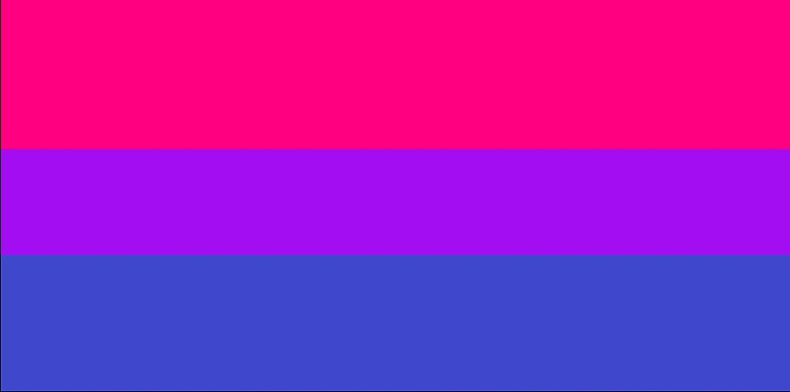As part of our LGTBQ+ series, Emma Hooker discusses the lack of positive bisexual representation and how this can lead to people struggling to find acceptance of their sexuality. It’s 2018 and LGBTQ+ History Month is upon us once again. There is so much history worth celebrating within our community, including this year being the forty-year anniversary of our beloved rainbow pride flag. However, when we look at history or even our contemporary culture, a strange and fascinating phenomenon occurs: bisexuality (and other multiple gender attraction) is too often belittled, skirted around, omitted and dismissed completely.
Anne Frank, known for her infamous diary, is a prime example of someone who has had her history omitted. When originally published, it was edited to remove the accounts which affirm her attraction to women. Annelise in the popular series, How To Get Away With Murder, is referred to as ‘complicated’ rather than ‘bisexual’. Piper of Orange Is The New Black is repeatedly referred to as ‘straight’ or ‘a lesbian’ depending on who she is currently involved with. Countless bisexual and pansexual comic book characters such asDeadpool, Harley Quinn, Poison Ivy, Mystique, Spider-Man and Catwoman have appeared on film, but they have all only explicitly engaged in heterosexual relationships.
“As a pansexual woman, I am perhaps more likely to notice bisexual erasure than some of my heterosexual and homosexual counterparts, but being attracted to multiple genders is increasingly commonplace”
As a pansexual woman, I am perhaps more likely to notice bisexual erasure than some of my heterosexual and homosexual counterparts, but being attracted to multiple genders is increasingly commonplace. According to recent surveys, within the demographic group aged 18-34, more than a quarter of people identify as LGBTQ+, with half of that community experiencing attraction to more than one gender. This corresponds to one in eight people of the general population, approximately eight million people across the UK. Out of curiosity, I surveyed 14 men and 26 women to see whether these statistics were reflected. Seventeen identified as something other than heterosexual, but more pertinently, seven women and five men explicitly identified themselves as bisexual or pansexual. For my focus group, at least one in four experienced attraction to multiple genders. With these statistics, you would hope to be bombarded with positive bisexual representation. However, according to GLAAD (the Gay and Lesbian Alliance Against Defamation), less than 5% of regular and recurring characters in television and Netflix series are LGBTQ+, with less than 1.5% of characters being bisexual.
Even worse, less than a third of these bisexual characters are male. To put that into perspective, there are approximately 5,800 regular and recurring characters in total where just 83 are bisexual and only 19 are bisexual men. The lack of positive representation for bisexuals leads to a second phenomenon: biphobia. Many people are aware of the classic stigmas and stereotypes against the bisexual community, but one stereotype is more harmful and present than others: that we do not exist at all. Many, if not most, people will say that they know a bisexual person or that they acknowledge bisexuality does exist. However, bisexual people are routinely discriminated against and attacked for their sexuality, so often forced to try and explain themselves, to pick a side, or reveal ‘what percentage’ heterosexual or homosexual they are, that it feels like bisexuality isn’t a valid response. This results in internalised biphobia; bisexuals themselves are made to feel so uncomfortable with their identity that they try and force themselves into mono-sexual moulds.
“within the demographic group aged 18-34, more than a quarter of people identify as LGBTQ+, with half of that community experiencing attraction to more than one gender…approximately eight million people across the UK”
When I was a teenager, I identified as a lesbian for a period because, if I didn’t, my attraction to women was not taken seriously. Men assumed that my bisexuality was for their benefit, a turn-on for them, whilst women assumed I just couldn’t get a boyfriend. I am not the only one to have experienced this. Of the twelve bisexuals I spoke to before writing this piece, five expressed that at some point they thought they must be gay, and one assumed that she must be straight and ‘faking’ her own attraction to women since she was also attracted to men. Seven expressed they wish or wished they could alter their sexuality to be straight as it would be ‘simpler’ and three wished they were either straight or gay, but not bisexual. Another three actually went so far as to temporarily identify as gay. Five otherwise questioned their bisexuality in ways different to those above, marking ‘internal debate and struggle’, ‘trying to hide part of [themselves]’, and feeling ‘pressure to choose’. Bisexual is still a word rarely spoken, and it is time for that to change. Slowly, we are making progress. Television shows like Brooklyn Nine-Nine made headlines with Rosa Diaz’s announcement that she is ‘bisexual’, and Crazy Ex-Girlfriend features a middle-aged man’s coming out story in a musical number called ‘Getting Bi’, but there is still a long way to go. We need the world to stop invalidating our sexuality by making it a word we cannot see, hear or say. We are not 50% gay and 50% straight, we are 100% bisexual.
Emma Hooker
[Image: Red Bubble]

